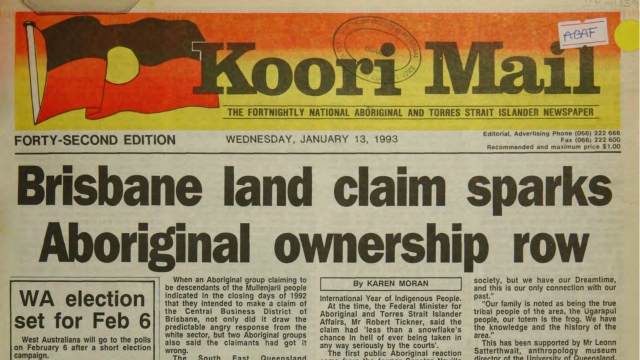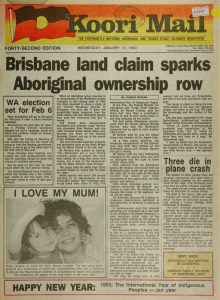
Case studies in complexity (part 3): Jagera, Yuggera and Ugarapul people
This article is part 3 of a series featuring case studies in complexity from the work of RealKM Magazine’s Bruce Boyes.
Background
- British colonisation of Australia had devastating consequences for Aboriginal people. Beginning with the arrival of the First Fleet in 1788, the British colonisation of the land mass that would later be named Australia led to1 “European-Aboriginal relations … [that] can be characterised as a period of dispossession, physical ill-treatment, social disruption, population decline, economic exploitation, codified discrimination, and cultural devastation.”
- In the city of Ipswich, Aboriginal people became refugees in what had been their own land. In response to concerns raised about the condition of Aboriginal people2 in the area, an Aboriginal Protection Society was established in the 1880’s in the city of Ipswich, which is located approximately 40 kilometres west of Brisbane, the capital city of the state of Queensland, Australia. “At that time the Aborigines were camped in Queens Park, Ipswich. In the space of nearly 50 years, they had been reduced from a ‘happy, healthy, energetic people’ to ‘lazy, dirty, drunken…thin, ragged and miserable. They were refugees in the true sense of the word.”
- Deebing Creek Aboriginal mission established in 1892. In 1889, the Aboriginal Protection Society was taken over by members of various local church groups. Then, in 1892, the first Queens Park campers were induced to move to an Aboriginal mission3 that had been established at Deebing Creek, a rural area south of Ipswich. The mission was intended as a retreat for the scattered remnants of tribes in the local area. In 1914, the mission was relocated to nearby Purga.
- Native title claims rejected on the basis of terra nullius. Later in the 20th century, Aboriginal groups throughout Australia sought to challenge colonial dispossession through the mounting of native title claims. However, these claims were unsuccessful because British claims to the possession of Australia were based on the doctrine of terra nullius (land belonging to no-one)4.
- Mabo decision overturns terra nullius and leads to Native Title Act 1993. A turning point came in 1992 when, in what would become known as the Mabo decision5 the High Court of Australia decided that terra nullius should not have been applied to Australia. Following on from the Mabo decision, the Parliament of Australia enacted the Native Title Act 1993 which has the objective of recognising and protecting native title.
- Mullenjarli claim. In the wake of the Mabo decision, the Mullenjarli people indicated in late 1992 that they were going to make a land claim over the central business district (CBD) of Brisbane.
Why it’s complex

- Conflict between Aboriginal groups in regard to claim. The Mullenjarli claim drew immediate criticism from two other Aboriginal groups who said that the claimants had got it wrong. As discussed in a front-page story in the Koori Mail newspaper, these groups were the Jagera and Ugarapul.
- Anthropological evidence for Ugarapul claim. As stated in the Koori Mail article, the anthropological evidence supports the Ugarapul as being “the original tribal people of the Ipswich and West Moreton area.”
- Assertion of Jagera claim by former Senator Neville Bonner. Also as stated in the Koori Mail article, Jagera elder Neville Bonner asserted his group’s claim to the area, stating that he was “the oldest living male member of the Jagera tribe.” Neville Bonner AO was the first Aboriginal Australian to become a member of the Parliament of Australia, serving as a Senator for Queensland from 11 June 1971 to 4 February 1983.
- Criticisms of Neville Bonner. Ugarapul group elders and members questioned the authenticity of Neville Bonner’s heritage, feeling that as a former Senator his claims of legitimacy came from white man’s politics, and not from having a genuine tribal connection to the Ipswich area.
- Jagera, Yuggera and Ugarapul people. While the Mullenjarli were found to have no relationship with Ipswich, a third group, the Yuggera, also laid claim to the area. This meant that native title in the Ipswich area was contested by three Aboriginal groups – the Jagera, Yuggera and Ugarapul.
- Loss of cultural roots as a result of colonisation. However, from the anthropological evidence, it appears that ‘Jagera’ may just be a different phonetic spelling of ‘Yuggera’ and the same-sounding ‘Ugara’ (with the ‘pul’ ending of Ugarapul potentially indicating a people-place association), and that the three groups are potentially actually the one. It’s not at all surprising that such confusion could occur, given the dispossession, social disruption, and cultural devastation that had occurred as a result of colonisation.
- Sensitivity to initial conditions. Complexity science informs us about how such situations can arise in complex systems. As discussed in our exploring the science of complexity series6, concept 5 of the 10 key concepts of complexity science alerts to how complex systems are sensitive to their initial conditions. As authors Ramalingam et al. state, “The interactions that are taking place at any moment in time have evolved from a previous moment in time, that is, all interactions are contingent on an historical process. Put simply, history matters in complex systems.”
Approach
- Mixed responses from agencies. At the time, Aboriginal cultural heritage and connections to land were typically only given tokenistic consideration in government agency policy and planning processes, if they were considered at all. In the Ipswich area, some agencies consulted with or involved just one of the three groups, while others used the conflict as an excuse to not involve any of the groups, or as an argument to continue their exclusion of Aboriginal groups if that’s what they’d already been doing.
- Jagera, Yuggera and Ugarapul People and Ipswich City ILUA. Ipswich City Council has been an exception to this, establishing an Indigenous Land Use Agreement (ILUA) under the Native Title Act 1993 with all three groups. The Jagera, Yuggera and Ugarapul People and Ipswich City Indigenous Land Use Agreement (ILUA) was registered on 19 September 2008.
Outcomes
- Conflicting claims continue. The Native Title Tribunal decided in favour of a native title claim by Yuggera Ugarapul representatives in August 2017, extinguishing the claims of the Jagera. The decision states that “I have decided that the claim in the Yuggera Ugarapul application satisfies all of the conditions in ss 190B and 190C of the Native Title Act 1993(Cth). Therefore,the claim must be accepted for registration and entered on the Register of Native Title Claims.” However, Jagera representatives reject this outcome in a December 2017 article in the Queensland Times newspaper. The article states that:
THE descendants of Australia’s most well-known indigenous politician are desperately trying to prove their heritage, amid claims their group is made up.
The family of Neville Bonner, Australia’s first indigenous member of parliament, are in a battle to regain recognition after their claim was successfully overthrown and an agreement with Ipswich City Council suspended.
The Jagera group has long been regarded as traditional owners of the land covering Ipswich and surrounds, along with the Yuggera and Ugarapul people. But a native title claim lodged by the Yuggera Ugarapul people approved in August, means that recognition has been extinguished.
- Dispossession, cultural devastation, and consultation issues continue. Protests are currently occurring in regard to a large residential development that is underway on land that had been reserved for the Deebing Creek Aboriginal mission (see Background section above). The developers, Frasers Property, have been accused of consulting with only the Jagera group and excluding Yuggera Ugarapul representatives. A February 2019 article in the Brisbane Times reports that:
Daniel Thompson, a blood descendant of “King Billy”, says his family’s elders have still not been directly included in the negotiations.
“King Billy Turner was made chief of Yuggera, mainly because he was engaged to build a trust between Aboriginal people and the ‘invaders’, I suppose,” he said …
Frasers said it began its discussions regarding Deebing Creek in 2015 with Indigenous consultancy group, Jagera Daran Pty Ltd, which has several employees linked to Mr Bonner’s family.
The firm’s director is Madonna Thomson, Mr Bonner’s grand neice [sic]. Jagera is a language group of the similar geographic region as the Yuggerah and Ugarapal, but with cultural differences.
Madonna Thomson said her family group was entitled to be part of talks with developers “as traditional owners to Jagera country who have interests in that site”.
“We have family members buried in that cemetery,” Ms Thomson said …
Frasers said in 2017 it then widened its talks with Indigenous families to include representatives from the Yuggera Ugarapul people as they lodged a successful Native Title application.
A series of six meetings with Yuggera Ugarapul members were held from November 2017 to May 2018 to develop a cultural heritage management plan.
Frasers says Yuggera Ugarapul representatives declined to sign this plan and a memorandum of understanding, and were instead seeking a political solution, the developer said.
Mr Thompson disputes this, saying his clan had not been included in talks.
“Comments have never been sought from the people with the truest links to this country,” he said.
Lessons
- History matters in complex systems. The conflicting native title claims between the Jagera, Yuggera, and Ugarapul people have persisted for more than 25 years, and can be expected to continue into the future. The conflict has its origins in the dispossession, social disruption, and cultural devastation that occurred as a result of colonisation. As Ramalingam et al. alert in concept 5 of the 10 key concepts of complexity science7, complex systems are sensitive to their initial conditions, so “The interactions that are taking place at any moment in time have evolved from a previous moment in time, that is, all interactions are contingent on an historical process. Put simply, history matters in complex systems.”
- Understanding the dynamics of change and promoting collective learning. In response, Ramalingam et al. recommend rethinking the scope of learning and the purpose of planning in an uncertain world8. In this regard, they quote a previous ODI working paper9 which states that:
planning should abandon prescriptive, goal-oriented decision making and prediction about future states and focus instead on understanding the dynamics of change and promoting a collective learning framework through which concerned stakeholders can constantly, through dialogue, express their respective interests and reach consensus
Ramalingam et al. caution that this raises issues in regard to the transferability of so-called ‘best practice’ (as we’ve also highlighted in another previous RealKM Magazine article). They also advise that it means that planning needs to accept a degree of uncertainty, that there needs to be a more systematic and realistic view of what the future can hold, and that path dependence and ’lock ins’ need to be avoided including use of the linear logical framework approach.
The approach recommended by Ramalingam et al. is reflected in my personal involvement in this case study, as discussed below, and a range of the other work I’ve undertaken, for example the Sustainable Management of the Helidon Hills Project. This other work will be the subject of future articles in this series.
My personal involvement in this case study
I had become interested in Aboriginal culture and heritage as a result of a number of camping trips to Blackdown Tableland in central Queensland in the 1970s and 1980s. Families from the nearby Woorabinda community were also camped there for most of my trips, and I observed with great interest how the elders were actively passing on their traditional knowledge to young people in the community.
Then, when living in Ipswich in the late 1980s and early 1990s, I developed an interest in environmental management and joined with other like-minded people to promote the conservation of important areas in that region. This included establishing the ‘Friends of White Rock’ group to promote the conservation of the bushland around White Rock, an iconic sandstone landmark located about 15km south-east of the Ipswich city centre. We convened a number of ‘Friends of White Rock’ bushwalks, and in response to media promotion of the walks we were telephoned by Aboriginal community representatives who expressed concern about people climbing on White Rock. They said that this would disrespect its cultural values, so we committed to discouraging people from climbing on the rock. Later I would learn that the community representatives who had contacted me were Ugarapul group members.
My interest in the Aboriginal culture and heritage of the Ipswich area was further piqued through my involvement in the Ipswich City Council Heritage Advisory Committee. The comprehensive university heritage study undertaken as part of the Ipswich Heritage Program had documented the rich Aboriginal heritage of the area, and I became concerned about the extent to which it was being protected. The academics carrying out the study reported regularly to the Heritage Advisory Committee. In one such briefing, University of Queensland anthropologist Dr. Leonn Satterthwait reported on the Ugarapul group’s concerns in regard to the lack of recognition of their culture and heritage, including their plans to seek a change of name for Namatjira Park, located in the Ipswich suburb of Collingwood Park. Namatjira Park had been named after well-known Aboriginal Australian artist Albert Namatjira, but the Ugarapul people argued that while Albert Namatjira was a significant historical figure, he had absolutely no connection with the Ipswich area.
A short time later I read in one of the local newspapers that the Ugarapul people had planned to hold a group meeting in Namatjira Park on Saturday 9 January 1993, where they would discuss issues of concern to the group. Being both interested in Aboriginal culture and sharing the Ugarapul people’s concerns in regard to the protection of their culture and heritage, I decided to go along to the gathering. I was hesitant to do this, because didn’t know how the sudden arrival of an unknown white man would be received – it would have been quite understandable for the group to have wondered who I was and what I was doing there. However, my fears in this regard were without basis, as the group was warm and welcoming. Dr. Leonn Satterthwait was also present, and able to confirm my membership of the Heritage Advisory Committee, and as discussion progressed we realised that two of the elders at the meeting were the community members who had talked to me by telephone in regard to their concerns about people climbing on White Rock. This Saturday 9 January Namatjira Park meeting is the one mentioned in the Koori Mail front-page story discussed above. Following the meeting, Ipswich City Council agreed to change the name of Namatjira Park to Goupong Park.
I subsequently worked with Dr. Leonn Satterthwait to arrange for the Ugarapul elders and a number of other group members to visit White Rock. The elders were old and frail, and while their own elders had told them stories about White Rock, the devastating dispossession and social disruption they had experienced meant that they had never seen the area. The visit was an incredibly emotional and moving experience – witnessing people who had been dispossessed from their land finally reunited with a site of great cultural significance to them. While travelling to the area I was also able to directly witness the discrimination faced by Aboriginal people. We had stopped at shops on the way for Dr. Leonn Satterthwait to pick up some additional items of lunch. While we were waiting in the vehicle, a police officer stuck his head in the window, and said “What’s going on here?” in a stern and commanding voice. Once we told him what we were doing he moved on. I was shocked by his racist action, knowing that a similar group of white people would not have been the target of such inappropriate suspicion. I would later witness more of this discrimination when sharing a flat with the grandson of one of the Ugarapul elders, Gladys Graham.
Also in 1993, I worked with the then Moreton Shire Council to facilitate the establishment of an Aboriginal Advisory Committee, which involved representatives of the Ugarapul and Jagera groups. At that time, Moreton Shire was a large rural local government area surrounding the much smaller Ipswich City Council local government area. Later, these two local government areas would be amalgamated to form the current Ipswich local government area. I had approached then Moreton Shire Council Mayor John Nugent with the Aboriginal Advisory Committee proposal in response to Ugarapul group concerns in regard to development proposals being progressed without due consideration for Aboriginal culture and heritage. These concerns included the Aboriginal community not being consulted at all in regard to a development near the culturally significant Ivory’s Rock, and developers employing archaeologists that were not thorough in their assessments and so did not have the support of the Aboriginal community. I was horrified to review the work of one such archaeologist to find that it had completely missed a major campsite with hundreds of stone tools. It was the most obvious place in the particular landscape for a major campsite, being on a relatively flat elevated ridge overlooking rainforest abundant in food resources at the junction of two major creeks, so it was seriously concerning that it had been missed. My idea for the Aboriginal Advisory Committee came from my experiences of the benefits of the multi-stakeholder Ipswich City Council Heritage Advisory Committee.
I was then lucky enough that my first visit in December 1993 to Australia’s capital city Canberra coincided with the Native Title Act 1993 being enacted by the Parliament of Australia. I was privileged to be in the gallery of the Senate Chamber of Parliament House when the Native Title Bill was passed by the Senate.
After leaving Ipswich in 1994 and moving further west to the Lockyer Valley, I continued to assist the Ugarapul group in any way that I could until I moved to Sydney in 2003. This included subsequently facilitating their involvement in the Sustainable Management of the Helidon Hills Project.
Later, while working on the Land & Water Australia Knowledge for Regional NRM Program, I convened a series of ‘How to work with knowledge providers’ workshops in Brisbane in November 2017. This included an Indigenous knowledge providers workshop.
References:
- Gardiner-Garden, J. (1999). From dispossession to reconciliation. Parliament of Australia Social Policy Group Research Paper 27 1998-99. ↩
- Habermann, D.(2003). Indigenous History. Deebing Creek & Purga Missions 1892-1948. Ipswich City Council. ↩
- Habermann, D.(2003). Indigenous History. Deebing Creek & Purga Missions 1892-1948. Ipswich City Council. ↩
- AIATSIS (n.d.). Overturning the Doctrine of Terra Nullius: The Mabo Case. AIATSIS NTRU Mabo v Queensland. Australian Institute of Aboriginal and Torres Strait Islander Studies (AIATSIS). ↩
- Reconciliation Australia (2017). 3 June: The Mabo decision. National Reconciliation Week 2017. ↩
- Ramalingam, B., Jones, H., Reba, T., & Young, J. (2008). Exploring the science of complexity: Ideas and implications for development and humanitarian efforts (Vol. 285). London: ODI. ↩
- Ramalingam, B., Jones, H., Reba, T., & Young, J. (2008). Exploring the science of complexity: Ideas and implications for development and humanitarian efforts (Vol. 285). London: ODI. ↩
- Ramalingam, B., Jones, H., Reba, T., & Young, J. (2008). Exploring the science of complexity: Ideas and implications for development and humanitarian efforts (Vol. 285). London: ODI. ↩
- Sellamna, N. (1999). Relativism in Agricultural Research and Development: Is Participation a Postmodern Concept? Working Paper 119, London: ODI. ↩
Also published on Medium.






Hi Bruce, your knowledge of first nations is great. I may have further information to assist. They moved us on not only from Queens Park but also the 1849 mission on the Bremer river.
Kind regards Daniel Thompson
I am an early childhood educator and I strongly believe that early education is important for our future generations to develop non-bias ,respect, fairness and work towards true reconciliation. where am I able to find more history of our local region. how may I form connections?
Hi Vinitha, as possible way to connect is through the Yuggera Facebook page https://www.facebook.com/Yuggera-308441532843486
I am wondering how to get more information and contacts of the Yaggera people and Turrbal people of Holland Park. I want to set up contacts at our school.
Many thanks Patricia for your enquiry. For Yuggera information and contacts, I would suggest their Facebook page, and for Turrbal, their website.